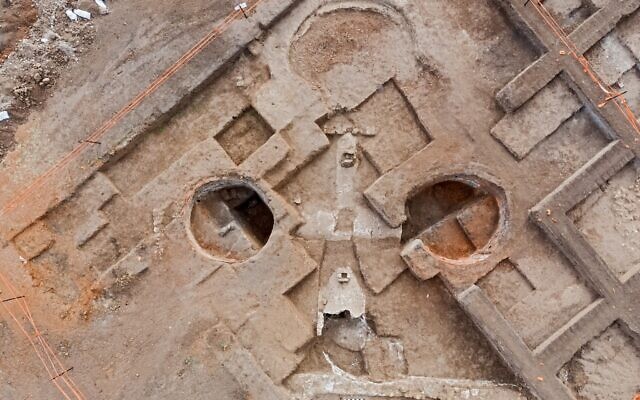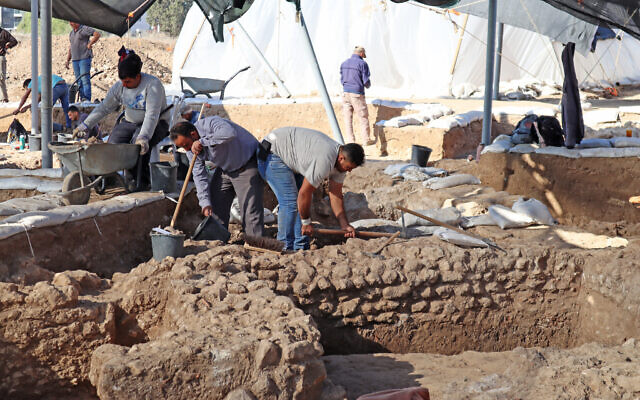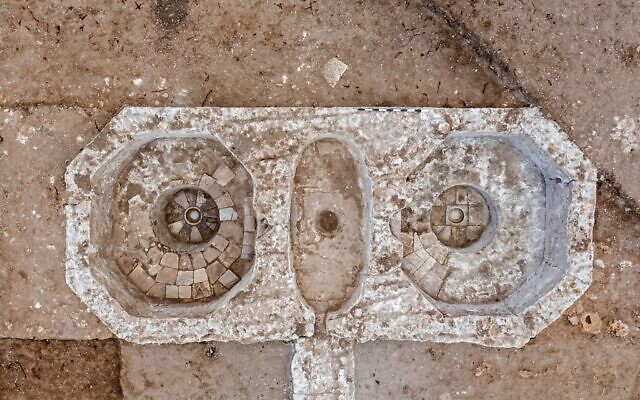Ancient Roman garum factory found in Israel, suitably far away from town
A small 1st century factory that produced fermented fish sauce — arguably the most desirable foodstuff of the Roman era — was recently uncovered during excavations near the southern coastal Israeli city of Ashkelon. It is one of the only identified industrial sites for production of the ubiquitous odorous sauce that has been found in the Eastern Mediterranean.
“We have something really unusual here,” Israel Antiquities Authority archaeologist Dr. Tali Erickson-Gini told The Times of Israel on Monday when the find was announced.
While the idea of fermented fish sauce or garum may not spark salivation in modern palates, the slimy stuff was considered one of the most delicious flavors of the Roman Empire. According to Erickson-Gini, the precious goop added both salty and savory flavors to food and was used in the vast majority of recipes known from the era.
“I think of it as a condiment, but it went well beyond that,” Erickson-Gini said. “It’s hard for us to imagine. It was far more common than ketchup.”
At the 2,000-year-old site, located two kilometers (a mile and a quarter) northwest of the city of Ashkelon, Erickson-Gini’s team uncovered several installations that, when taken together, left the archaeologist with little doubt that she was looking at a rare Holy Land garum production center, or cetaria, she said. Though there are few examples in the eastern Mediterranean, she said that in the Iberian Peninsula, specifically Malaga, there are several installations that mirror what she has uncovered in Ashkelon.

The Ashkelon site was excavated ahead of the construction of an Eco-Sport Park. Local pupils and youth aided in the excavation, which was underwritten by the Municipality of Ashkelon and the Ashkelon Economic Co.
In addition to evidence of fish pools, the team uncovered giant plastered vats, jars used for storing liquid, and what appears to be a large receptacle to hold the strained goopy substance.
While fish pools have been found elsewhere in the region, there is only one other identified location in Israel that may possibly have produced the garum, at Dor, said Erickson-Gini. According to what has so far been excavated, the Ashkelon site was not a major factory, and was possibly largely for local use.

The paucity of production sites had always surprised and puzzled the archaeologist, she said. Throughout the Empire, the sauce graced the tables of the Roman world’s rich and famous, as well as the troughs of commoners.
“What interests me is the fact that this product was very, very popular in the Roman and Byzantine period. As popular as it was, you’d expect to find a lot of installations. I’m shocked we haven’t found more of them in excavations,” she said.
Roman historian Pliny the Elder mentions the sauce throughout his “Natural History,” both as a foodstuff and as medicine. According to a recent National Geographic article on garum, Pliny “extols garum as a cure for dysentery and an effective treatment for dog bites. Pliny also recommended it for earaches, and believed that consuming African snails marinated in garum would ward off stomach troubles.”Volume 90%
The National Geographic article states that the sauce was considered so essential to the Roman diet “that a huge network of trade routes grew up to move the prized relish from fishery to plate. Like many delicacies today, the finest garum could sell for astronomical sums.”
Even in the storerooms of 1st century BCE King Herod’s isolated Masada palace, a rare labeled amphorae of garum was found that was possibly imported from Andalusia.
The secret’s in the sauce
The production of the malodorous sauce must have been a stomach-roiling business. In later periods, due to its powerful reek, laws were legislated that the prized fermented fish “ketchup” must be produced outside of urban centers.
To accomplish its pungent putrefaction, the craftsman would place whole small fish such as sardines or anchovies, or chopped up larger fish such as tuna or mackerel, at the base of a jar and pour on top of it spices and salt, followed by another fish layer, etc. According to Erickson-Gini, the recipe’s ratio called for five parts fish to one part salt.
A lively video, “Garum, Rome’s Favorite Condiment (Ancient Cooking),” on the Invicta History YouTube channel, said the concoction inside a closed jar would bake in the hot Mediterranean sun for a week as the fish deteriorated, but was saved from rot by the salt. It was then opened and stirred for another 20 days or more (Erickson-Gini suggested up to three months).
The resultant “puree of fish goop” was strained through a basket, and the strained liquid is the garum. Other, more solid leftovers could be made into a different sauce or lesser-regarded fish paste called allec.
There are several types of garum, and even a strictly kosher version called garum castimonarium that was guaranteed to be made from kosher fish, not shellfish.
Foodie fashion fades
The height of the garum fad was circa the 2nd century CE, but its use is recorded even much later.
According to an IAA press release, the Ashkelon production site was abandoned and industry in the area turned to viticulture.
Erickson-Gini said that even during the time of the garum production, there is evidence of wine presses and storage jars located only meters away. Later, circa 5th century in the Byzantine period a thriving monastic community produced wine.
Although there are scant artifacts from the central elaborately decorated church, three winepresses were built nearby, as well as a large kiln complex that would have produced jars to export the wine all over the Byzantine Empire. “Jars were found as far as England and Germany and Yemen,” said Erickson-Gini.

Later, the site was abandoned in circa the 7th century after the Islamic conquest. According to Erickson-Gini and evidence she found in refuse pits containing the bones of large pack animals, “nomadic families, probably residing in tents, dismantled the structures and sold the different parts for building material elsewhere.”
This post appeared first at https://www.timesofisrael.com/factory-for-romans-favorite-funky-fish-sauce-discovered-near-ashkelon/
See all posts in Biblical Archaeology News & Opinion
Upcoming Tours
We would love to walk with you in the Holy Land. Here are upcoming opportunities:
Jun 27 — Jul 09, 2024 Egypt & Jordan Walking Tour (easy pace)Led by George DeJong |
All trip dates subject to change.
